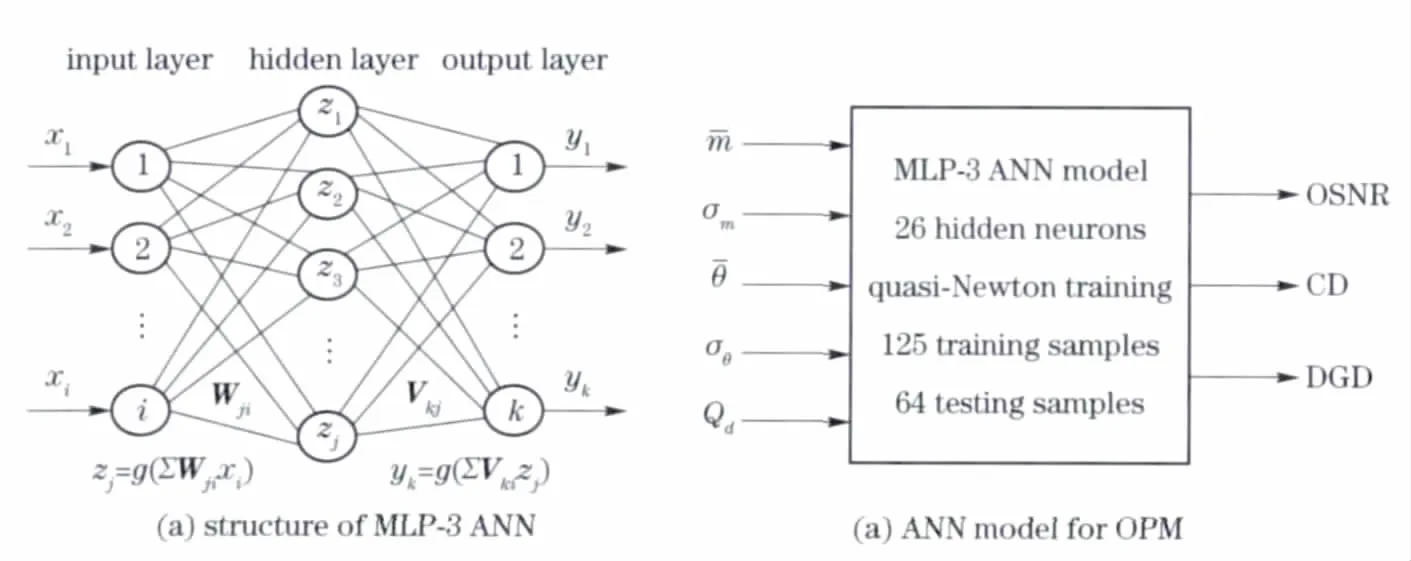Multiple-impairment monitoring for optical duobinary system based on delay-tap asynchronous sampling
LAI Jun-sen(赖俊森), YANG Ai-ying(杨爱英), SUN Yu-nan(孙雨南)
(1.School of Optoelectronic,Beijing Institute of Technology,Beijing 100081,China;2.China Academy of Telecommunication Research of MIIT,Beijing 100191,China)
The increasing internet traffics demand has promoted the fiber communication systems to upgrade from 10 Gbit/s to 40 Gbit/s and above.Optical duobinary modulation format has attracted much attention due to its large tolerance to chromatic dispersion,compact signal spectrum which ensure high spectral efficiency transmission,and resilience to nonlinear effects[1-3].The development of high speed,transparent and reconfigurable optical networks appeals for optical performance monitoring(OPM)to ensure high quality of service[4].Crucial impairments in optical networks include opticalsignal-to-noise ratio(OSNR),chromatic dispersion(CD),and polarization mode dispersion(PMD).
Several delay-tap asynchronous sampling based optical performance monitoring(OPM)techniques have been proposed for multiple-impairments monitoring,including support vector machine[5],artificial neural networks[6],Hough transform[7],and Hausdorff distance measure[8].In delay-tap asynchronous sampling,theconcerned signal is sampled without regard to an instant relative to a decision time,which means this method can be implemented in high bit rate systems without requiring data clock recovery.However,its effectiveness for optical duobinary signal was not fully demonstrated.
In this paper,we present a novel optical performance monitoring technique for 40 Gbit/s optical duobinary signal based on delay-tap asynchronous sampling method.Using statistical analysis together with an artificial neural networks(ANN)model[9],we demonstrate multiple-impairment monitoring with OSNR,CD,and differential group delay(DGD),i.e.first order PMD,in the ranges of 26 dB to 42 dB,0 to 160 ps/nm,and 0 to 16 ps respectively.A correlation coefficient of 0.98 is reported for a set of testing data from the 40 Gbit/s duobinary system.The monitoring root-mean-square(RMS)errors are 0.51 dB for OSNR,3.75 ps/nm for CD,and 0.92 ps for DGD.
1 Methodology
The proposed multiple-impairmentmonitoring schemeisbased on thedelay-tap asynchronous waveform sampling technique[5]as illustrated in Fig.1a.Tbis the bit period,Δt=0.5Tbis the fixed delay time,and Tsis the sampling period,which is not related to the monitored signal bit rate,and can be much longer than Tb.This technique combines the originalasynchronous sampling and a two-tap delay line so a pair of data could be obtained during one sampling process.Each sample pair consists of two measurements(E(xi),E(yi)),separated by Δt.Because the sample pairs obtained are from the same pulse or the adjacent pulses,they can reflect the pulse shape information which has a definite relationship with the impairments.

Fig.1 Application of asynchronous delay tap sampling in optical performance monitoring
The samplepairs are then plotted in a two-dimension scatter plot,which is known as delay-tap plot.Fig.1b shows several eye diagrams(the upper row)and delay-tap plots(the lower row)for 40 Gbit/s optical duobinary signal,which are simulated in OptisimTM,at a few select combinations of OSNR,CD,and DGD.Visually,it is obvious that the impairments produce distinct features on both eye diagrams and delay-tap plots.Half-symbol(Δt=0.5Tb)delay length represented the power evolution within each bit and highlighted the impairments distortion effects[10].The delaytap plots provide almost the same information richness as eye diagrams in the application of OPM.In order to simultaneously quantify the impairments,we use ANN model trained with parameters derived from delay-tap plots.

Fig.2 Application of MLP-3 ANN model in optical performance monitoring
ANN is neuroscience-inspired computational tool that is trained by use of input-output data to generate a desired mapping from an input stimulus to the targeted output[11].The application of ANN in multiple-impairment monitoring has been exhaustively reported[9].As shown in Fig.2a the ANN architecture used in this work is a feed-forward,three-layer preceptor structure(MLP-3)consisting of an input layer,a hidden layer,and an output layer.The mapping of input-output relationships is given by Y=g[V·g(W·X)],where X is the input vector,Y is the output vector,and W and V are respectively the weight matrices between the input and hidden layers and between the hidden and output layers.The function g(u)used in this work is a nonlinear sigmoidal activation function given by g(u)=1/[1+exp(- u)],where u is the input to a neuron.In order to extract impairments information from the delay-tap plots,we calculate the means and standard deviations of the magnitudes of sample pairs from original(,σm),the means and standard deviations of the angle of sample pairs from original(,σθ),and the Q-factor along the diagonal(Qd),which is given bywhere d1and d0are the magnitudes of sample pairs along the diagonal.ANN model consists of five inputs,three outputs(OSNR,CD,and DGD),and 26 hidden neurons,as shown in Fig.2b.The quasi-Newton method is used as training algorithm,and the ANN is trained by use ofa software package developed by Zhang[12].
2 Simulation results
The configuration of the proposed multipleimpairment monitoring scheme in 40 Gbit/s optical duobinary system is shown in Fig.3.40 Gbit/s 27-1 pseudo-random bit sequence(PRBS)was precoded and then filtered by a 10 GHz Bessel electrical low-pass filter(LPF)to provide threelevelmodulator drive waveform.Continuous wave(CW)light at 1 550 nm was externally modulated by a chirp-free dual drive Mach-Zehnder modulator(MZM)to produce optical duobinary signal.An erbium-doped fiber amplifier(EDFA)and a variable optical attenuator(VOA)were used to adjust the OSNR level of the system.The input optical power of single mode fiber(SMF)was set to 0dBm,fiber parameters,including length,CD and PMD coefficient,were changed to simulate different amount of CD and PMD degradation.After filtered by a 1nm Bessel optical band-pass filter(BPF),the impairments-loaded signals were detected by photodiode (PD).Then,the electrical signals were split into two branches and a fixed delay Δt=0.5Tbwas introduced in one branch.The sample pairs were obtained by low-speed asynchronous sampling,and collected for further ANN model off-line processing.

Fig.3 Simulation model of the multiple-impairment monitoring in 40 Gbit/s optical duobinary system
To illustrate this OPM method,we performed a set of 125 simulations to form training samples for ANN training,which using the following impairment combinations:OSNR 26 dB,30 dB,34 dB,38 dB,and 42 dB;CD 0,40 ps/nm,80 ps/nm,120 ps/nm,and 160 ps/nm;and DGD equals 0,4 ps,8 ps,12 ps,and 16 ps.The training error of ANN after 200 epochs is 0.03,as shown in Fig.4a.Once the ANN model was trained,its accuracy was validated with another set of 64 testing samples with different impairment combinations:OSNR 28 dB,32 dB,36 dB,and 40 dB;CD 20 ps/nm,60 ps/nm,100 ps/nm,and 140 ps/nm;DGD 2 ps,6 ps,10 ps,and 14 ps.The software reported a correlation coefficient of 0.98 for the testing samples and ANN model outputs.Figs.4b - 4d compares the testing samples and ANN model outputs for OSNR,CD,and DGD.The monitoring RMS errors were 0.51 dB for OS- NR,3.75 ps/nm for CD,and 0.92 ps for DGD.

Fig.4 Optical performance monitoring results
3 Conclusion
We havepresented a novel approach for multi-impairment monitoring in 40 Gbit/s optical duobinary system by using ANN models trained with parameters derived from the delay tap plots.Firstly,the optical signal is delay tap sampled to obtain two-dimensional histogram,known as delay tap plots.Secondly,the features of delay tap plots are extracted to train the feed forward,three-layerpreceptorstructure artificial neural networks.Finally,the outputs of trained neural network are used to monitor optical duobinary signalimpairments.This method provides a promising technique for simultaneous identification multiple-impairment of optical channels without requiring synchronous sampling or data clock recovery. The proposed technique issimple,cost-effective and suitable for in-service distributed OPM.
[1] Price A J,Mercier N L.Reduced bandwidth optical digital intensity modulation with improved chromatic dispersion tolerance[J].Electronic Letters,1995,31(1):58-59.
[2] Winzer P J.Advanced modulation formats for highcapacity optical transport networks[J].Journal of Lightwave Technology,2006,24(12):4711-4728.
[3] Liu Xiang,Wei Xin,Gnauck A H,et al.Suppression of intrachannel four-wave-mixing-induced ghost pulses in high-speed transmissions by phase inversion between adjacent marker blocks[J].Optics Letters,2002,27(13):1177-1179.
[4] Kilper D C,Bach R,Blumenthal D J,et al.Optical performance monitoring[J].Journal of Lightwave Technology,2004,22(1):294-304.
[5] Anderson T B,Kowalczyk A,Clarke K,et al.Multi impairment monitoring for optical networks[J].Journal of Lightwave Technology,2009,27(16):3729-3736.
[6] Wu Xiaoxia,Jargon J A,Wang Chihming,et al.Experimental comparison of performance monitoring using neural networks trained with parameters derived from delay-tap plots and eye diagrams[C]∥OSA.Proceedings of OFC 2010.San Diego,United States:[s.n.],2010:JThA17-4.
[7] Kozicki B,Maruta A,Kitayama K I.Experimental investigation of delay-tap sampling technique for online monitoring of rz-dqpsk signals[J].IEEE Photonics Technology Letters,2009,21(3):179-181.
[8] Zhao Jian,Lu Chao,Lam Kinman,et al.A novel optical signal monitoring method of DPSK signal based on delay tap sampling and Hausdorff distance measure[C]∥OSA.Proceedings of CLEO/QELS 2008.California,United States:[s.n.],2008:JWA108-3.
[9] Wu Xiaoxia,Jargon J A,Skoog R A,et al.Applications of artificial neural networks in optical performance monitoring[J].Journal of Lightwave Technology,2009,27(16):3580-3589.
[10] Dods S D,Anderson T B.Optical performance monitoring technique using delay tap asynchronous waveform sampling[C]∥OSA.Proceedings of OFC 2006.Anaheim,United States:[s.n.],2006:OThP5-7.
[11] Hassoun M H.Fundamentals of artificial neural networks[M].Cambridge,MA:The MIT Press,1995.
[12] Zhang Q J.NeuroModeler.ver.1.5 [EB/OL].(2010-06-01)[2011-05-02].http:∥www.doe.carleton.ca/~ qjz/.
 Journal of Beijing Institute of Technology2013年2期
Journal of Beijing Institute of Technology2013年2期
- Journal of Beijing Institute of Technology的其它文章
- Self-diagnosis method for faulty modules on wireless sensor node
- Optical micro-scanning location calibration of thermal microscope imaging system
- Experimental study on durability fracture behavior and vibration modal sweep for vehicle rear axle
- Control strategy for hybrid tracked vehicles using fuzzy logic
- Strategy to control crawling vehicles with automated mechanical transmission
- Roundness error evaluation by minimum zone circle via microscope inspection
